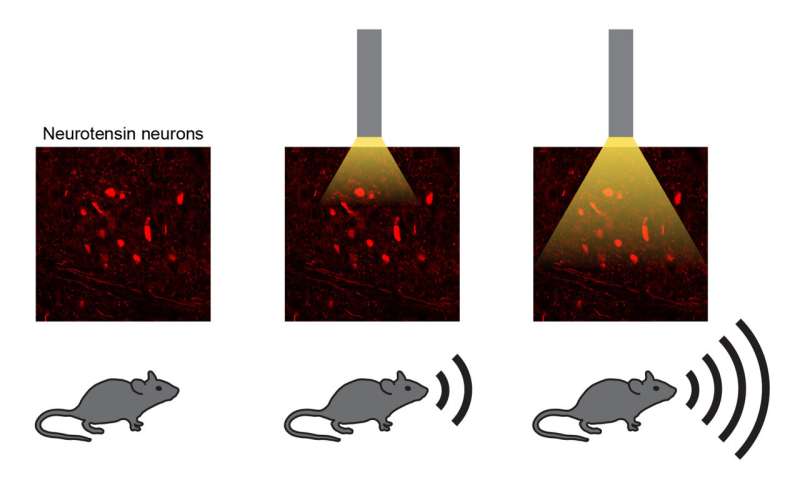December 11, 2023 feature
This article has been reviewed according to Science X's editorial process and policies. Editors have highlighted the following attributes while ensuring the content's credibility:
fact-checked
peer-reviewed publication
trusted source
proofread
A cluster of genetically defined brainstem neurons involved in the production and modulation of sounds

Humans and other mammals can produce a wide range of sounds, while also modulating their volume and pitch. These sounds, also known as mammalian vocalizations, play a central role in communication between both animals of the same and of different species.
Researchers at Stanford University School of Medicine recently carried out a study aimed at better understanding the neural mechanisms underpinning the production and modulation of mammal vocalizations. Their paper, published in Nature Neuroscience, identifies a neural circuit and a set of genetically defined neurons in the mouse brain that play a key role in the production of sound.
"All mammals, including humans, vocalize by pushing air past the vocal cords of the larynx, which vibrate to produce sound," Avin Veerakumar, co-author of the paper, told Medical Xpress.
"Acoustic features of the sound, such as volume and pitch, convey meaning to the listener and are controlled by approximately 40 different muscles. Despite the importance of vocalization and the prevalence of speech disorders, we have a limited understanding of how the brain produces sound and controls acoustic features."
Past studies suggest that the brainstem, the structure connecting the primary brain structure to the spinal cord, plays a crucial role in mammalian sound production. The primary objective of the recent work by Veerakumar and his colleagues was thus firstly to identify specific brainstem neurons that support vocalizations.
"We also hoped to identify a gene marker to distinguish these neurons from the surrounding neurons," Veerakumar explained. "To identify gene markers of brainstem vocalization neurons, we searched the Allen Mouse Brain Atlas, a publicly available mouse gene expression database. We looked for genes that are expressed in a particular region of the brainstem that has been implicated in sound production, called the nucleus retroambiguus."
The analyses carried out by Veerakumar and his colleagues yielded some very interesting results. Firstly, the researchers found that a gene called neurotensin was expressed in a small cluster of approximately 160 neurons within the nucleus retroambiguus.
They then carried out further experiments, in which they used optogenetic techniques to manipulate neurons expressing this gene as they were recording the vocalizations of mice.
"We found that the neurotensin-expressing neurons were activated during both neonatal and adult vocalizations," Veerakumar said. "We also showed that the neurotensin neurons were essential for sound production, as the mice were rendered mute when these neurons were ablated (i.e., removed). Remarkably, activating the neurotensin neurons caused mice to vocalize even under general anesthesia, and increasing the firing rate of these neurons increased the volume, but not pitch, of the produced sound."
The results gathered by Veerakumar and his colleagues suggest that neurotensin-expressing neurons in the nucleus retroambiguus are not only implicated in the production of mouse vocalizations, but also control the volume of sounds produced by the animals. The neurotensin neurons seem to achieve this by co-activating motor neurons that specifically control the vocal cord and abdominal expiratory muscles.
"By increasing the expiratory force, the volume of the produced sound increases, just like a wind instrument," Veerakumar explained.
The recent work by this team of researchers offers some new insights into the neural underpinnings of mammalian vocalizations. The role of the brain circuit and genetically defined neurons they identified could soon be further explored in future studies on mice and other mammals.
"An important next step for us will be to use the neurotensin gene marker we identified to search for homologous neurons in other vocalizing species, such as humans, other mammals and birds," Veerakumar added.
"While we identified neurons that specifically control sound volume, our study did not identify the neurons that control pitch, syllable structure, or syntax. We are interested in finding gene markers for neurons that control these other important acoustic features, which convey meaning to the listener."
More information: Avin Veerakumar et al, A brainstem circuit for phonation and volume control in mice, Nature Neuroscience (2023). DOI: 10.1038/s41593-023-01478-2.
© 2023 Science X Network





















